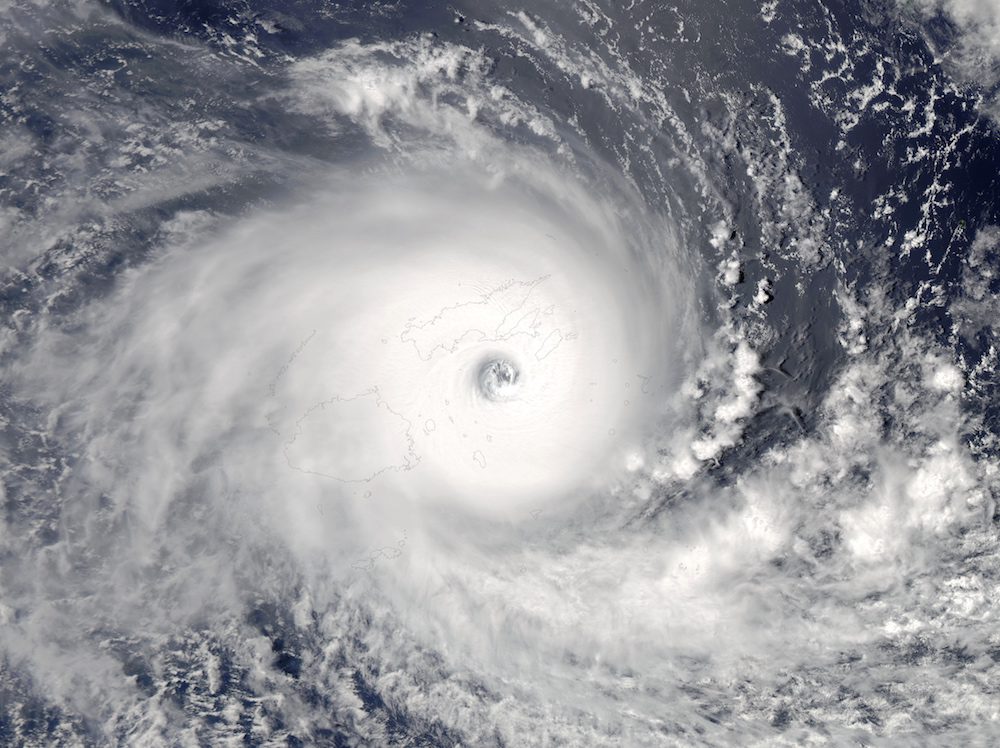The Aqua satellite captured this picture of Tropical Cyclone Winston at 01:30 UTC on 20 February 2016, during peak intensity and striking Fiji. Later, Winston became the strongest storm to make landfall over Fiji since records began. Photo credit: NASA
By Emma O’Brien
(Bloomberg) — Fiji is surveying the damage from the strongest tropical cyclone to ever hit the South Pacific nation, with at least three people reported to have been killed and whole villages flattened as the storm tracked across the archipelago.
A state of natural disaster is in place across Fiji and a curfew imposed on Saturday evening local time won’t be lifted until 5:30 a.m. on Monday, said Ilaisa Silimaibau, a spokesman for the country’s National Disaster Management Office. Strong wind and heavy rain warnings remained in force for Fiji with Tropical Cyclone Winston located about 340 kilometers (211 miles) west of Nadi, the main tourist hub, as of 3 p.m. on Sunday.
The storm, which the Fiji Meteorological Service classified a Category 5 on the five-step Australian scale, brought winds of up to 220 km an hour as it peaked over Fiji’s eastern islands, making it the most severe cyclone on record to make landfall there, according to Emma Blades, a meteorologist with MetService, New Zealand’s meteorological office.
“It was so strong that the weather stations there actually went down, they just stopped recording,” Blades said by phone from Wellington. “People were saying that roofs just popped off. I can’t even imagine what that sort of wind feels like.”
Death Toll
At least three people have been confirmed dead, two of them killed when the house they were in collapsed, Associated Press reported, citing the disaster management office. Police are also investigating reports of another two deaths, according to AP. All homes were destroyed in some villages, the Australian newspaper said, citing Twitter posts from Jone Tuiipelehaki, a communications officer for the United Nations Development Program.
More than 2,000 people have taken refuge in evacuation centers throughout Fiji, which has a population of about 900,000, as officials and aid agencies start to assess the scope of the cleanup. All schools will be closed for a week to check for damage and universities will shut Monday until further notice, according to Fiji government announcements on Facebook.
New Zealand sent an air-force plane early Sunday to assist Fiji with surveying the impact, amid evidence of major damage on the northern coast of Viti Levu, the country’s biggest and most populated island, Foreign Minister Murray McCully said in an e- mailed statement.
His Australian counterpart, Julie Bishop, offered assistance and is advising all citizens to avoid traveling to Fiji, which counts tourism as its biggest industry. At least 1,300 Australians are registered as being in the country with the Department of Foreign Affairs & Trade, but the number is likely to be much higher, Bishop told the Australian Broadcasting Corp. on Sunday. Air carriers including Fiji Airways and Virgin Australia Holdings Ltd. canceled flights to and from Nadi over the weekend.
Houses Destroyed
Photos posted on the government’s Facebook page showed flooding and uprooted trees in central Nadi, which is on the western side of Viti Levu. In Lautoka, Fiji’s second-largest city, entire houses were ripped apart and power poles felled. Red Cross workers are out assessing the damage, according to Twitter posts. Ahmad Sami, the acting chief of the International Federation of Red Cross and Red Crescent Societies in Fiji, described it in an online video as the nation’s “worst disaster ever.”
Winston hit outlying islands in neighboring Tonga last week before circling back toward Fiji. The cyclone was likely to continue west across the Pacific Ocean on Sunday before moving south, meaning it could potentially head toward New Zealand, though probably in a more weakened form, according to Blades at the MetService in Wellington.
More than 20 people were killed in March last year as Cyclone Pam, another Category 5 storm, hit directly into Vanuatu, about 750 miles northwest of Fiji.
©2016 Bloomberg News

 Join The Club
Join The Club











